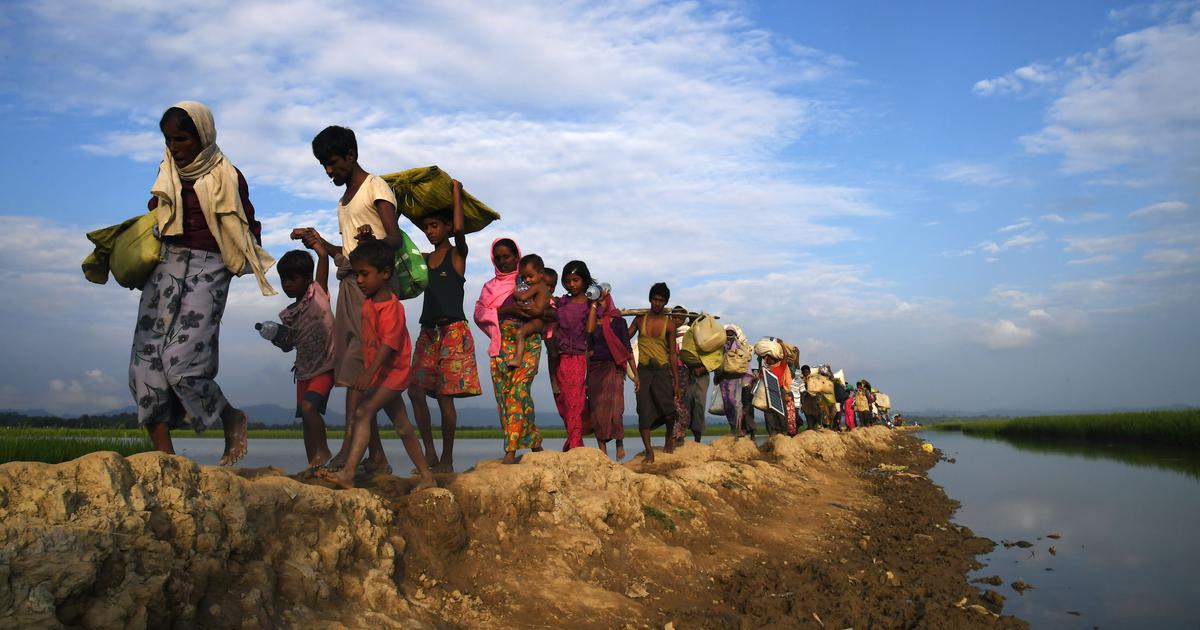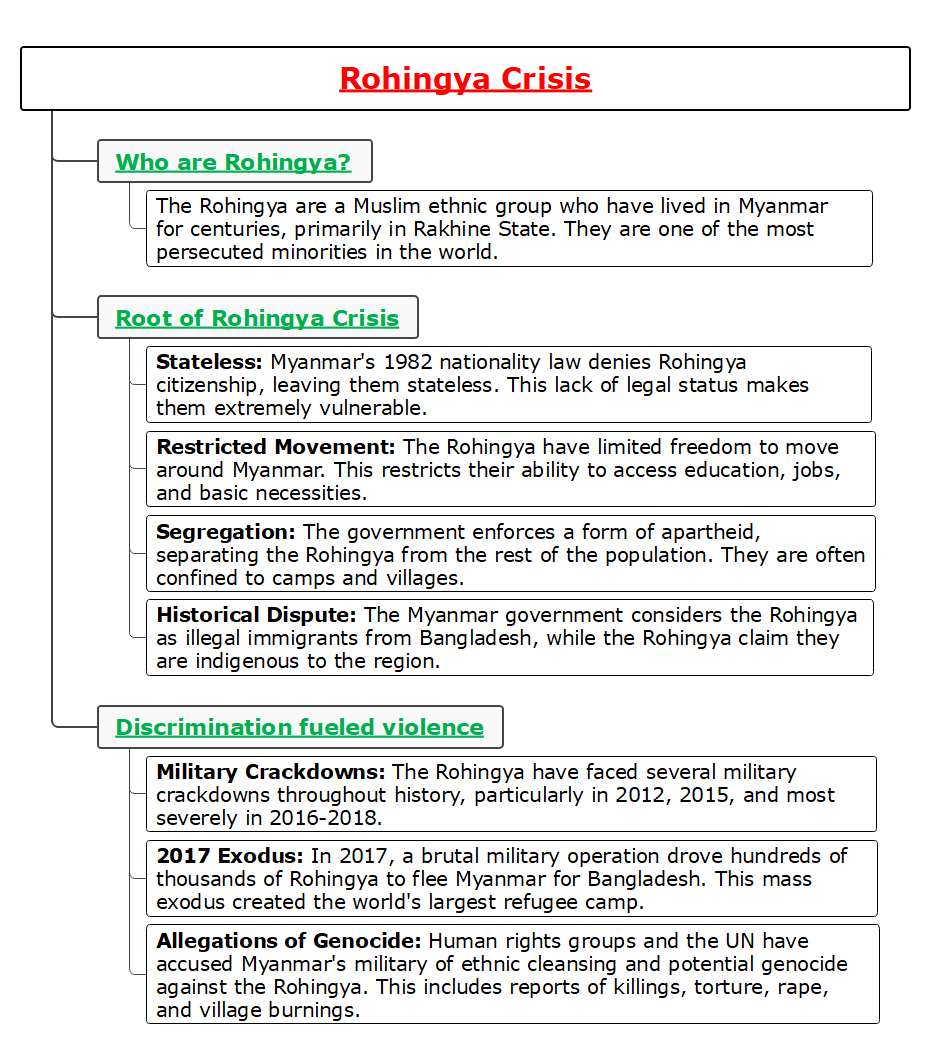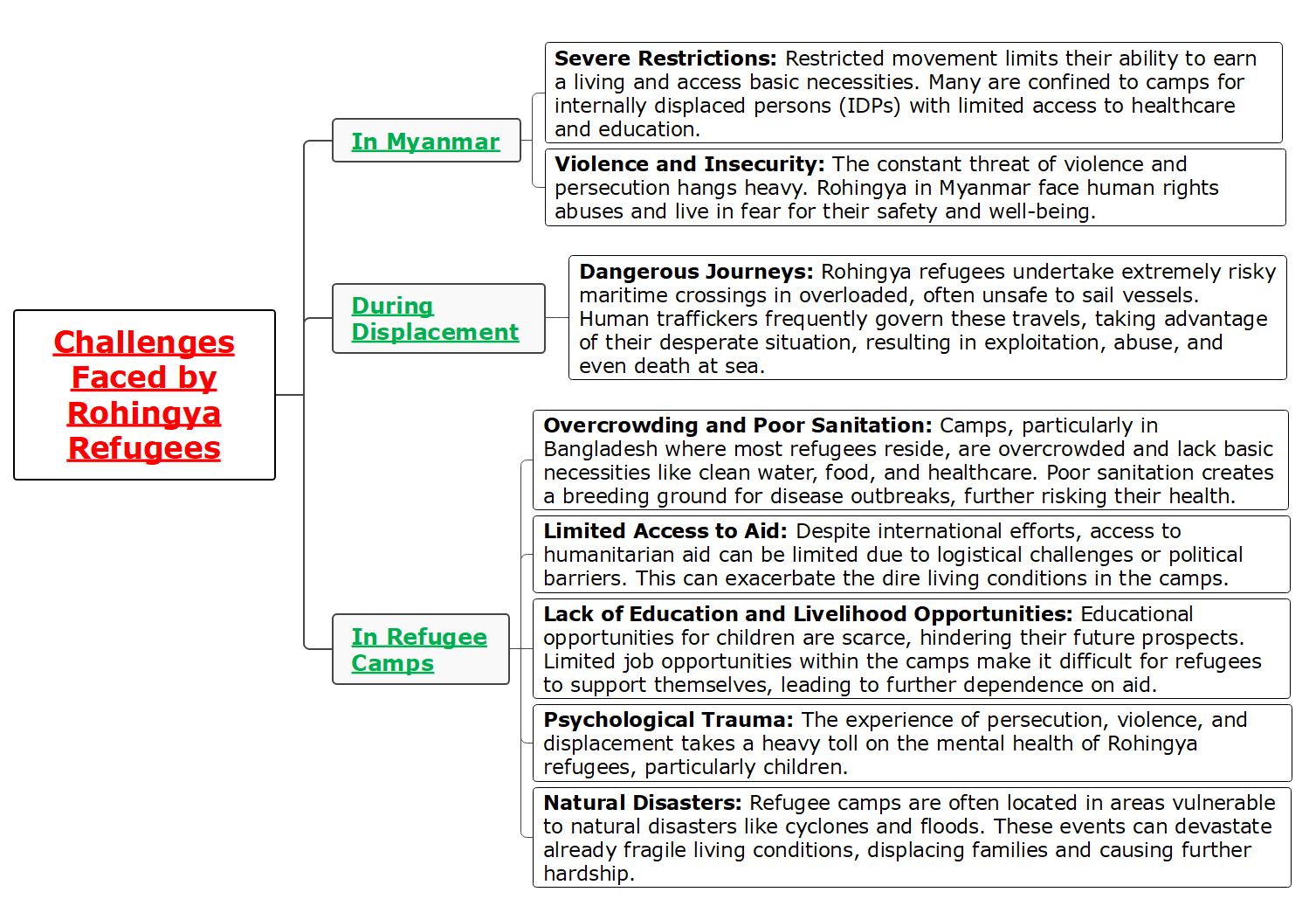
Copyright infringement not intended
Picture Courtesy: https://scroll.in/article/910836/fear-has-intensified-why-rohingya-refugees-are-fleeing-india-for-bangladesh
Context: The recent sinking boat tragedy near the Indonesian coast highlights the ongoing Rohingya refugee crisis.
Details
- The recent rescue of Rohingya refugees from a sinking boat near the Indonesian coast presents an extreme example of the ongoing Rohingya refugee crisis.
- The current crisis has existed for years, highlighted by the desperate attempts of Rohingya people to escape persecution and seek refuge in neighbouring countries.
- The incident outlined the horrible circumstances faced by Rohingya refugees and the urgent need for global intervention to address their humanitarian crisis.
|
Historical Background
●The Rohingya people emerged from the Arakan Kingdom in the area that is now Myanmar's Rakhine State.
●Despite residing in the region for centuries, they have experienced systematic discrimination and persecution from both the Myanmar government and the majority Buddhist population.
●The denial of citizenship rights in 1982 left them stateless, denying them access to basic rights and security.
●Tensions between the Rohingya and the Myanmar government have risen over time, resulting in bloodshed and displacement.
|
A Long History of Discrimination
- The roots of the Rohingya crisis run deep. For decades, the Myanmar government has denied the Rohingya their basic rights and freedoms.
- They have been denied citizenship, forced to live in segregated communities, and subjected to violence and repression.
- This systematic discrimination has created a climate of fear and insecurity for the Rohingya.

2017: A Turning Point
- The situation for the Rohingya worsened dramatically in 2017. In response to attacks by Rohingya militants, the Myanmar military launched a brutal crackdown in Rakhine State. This crackdown involved widespread violence against Rohingya civilians, including killings, rape, and arson.
- Hundreds of thousands of Rohingya were forced to flee their homes and cross the border to Bangladesh, creating a massive humanitarian crisis.
The International Response
- The international community has condemned the violence against the Rohingya and called for accountability for those responsible.
- The UN has launched an investigation into crimes against humanity in Myanmar. However, the Myanmar government has resisted international pressure and continues to deny any wrongdoing.

Challenges Faced by Rohingya Refugees
- The Rohingya people, forced to flee their homes in Myanmar, face several challenges throughout their journey. These difficulties begin in Myanmar and continue throughout their journey and stay in refugee camps.

|
The challenges faced by Rohingya refugees are immense and require a comprehensive and long-term approach from the international community. Addressing the root causes of the crisis in Myanmar alongside ensuring the safety and well-being of refugees is essential for a sustainable solution.
|
Efforts to Address the Rohingya Crisis
Humanitarian Assistance
- The United Nations High Commissioner for Refugees (UNHCR) plays a central role in coordinating relief efforts. They provide vital aid such as food, clean water, shelter, and sanitation facilities in refugee camps.
- Numerous NGOs work tirelessly alongside the UNHCR to deliver healthcare services, educational programs, and psychological support to refugees.
- Many countries donate critical funds to support humanitarian organisations working on the ground.
Protection and Advocacy
- The UN and human rights organisations actively advocate for the rights of the Rohingya people. They document human rights abuses, lobby for international pressure on Myanmar, and call for accountability for those responsible for atrocities.
- The International Criminal Court (ICC) is investigating potential crimes against humanity committed against the Rohingya. This legal push seeks justice for the victims and sends a strong message of deterrence.
Addressing Displacement
- Some countries offer limited resettlement opportunities for Rohingya refugees. While these programs provide a safe haven for a small number of refugees, they are not a large-scale solution.
- International efforts also provide support to Bangladesh and other countries hosting large numbers of refugees. This helps to ease the burden on these nations and improve the overall living conditions in the camps.
Long-Term Solutions
- The international community is pressuring the Myanmar government to address the root causes of the crisis. This includes demands for an end to persecution, granting Rohingya citizenship rights, and ensuring safe repatriation conditions for those who wish to return.
Way forward to Address the Rohingya crisis
Addressing Root Causes in Myanmar
- Ending Persecution and Ensuring Citizenship: The Myanmar government must end the persecution of Rohingya and grant them full citizenship rights. This includes dismantling discriminatory laws and policies and recognizing the Rohingya as a legitimate ethnic group.
- Promoting Accountability: Holding perpetrators of human rights abuses accountable is crucial. International pressure and legal avenues like the International Criminal Court can play a role in achieving justice.
- Truth and Reconciliation: Establishing a truth and reconciliation commission can help foster healing and prevent future violence. This process would involve acknowledging past wrongs and creating a pathway towards peaceful coexistence.
Supporting Rohingya Refugees
- Improving Conditions in Camps: Humanitarian organisations need continued support to improve living conditions in refugee camps. This includes providing adequate food, clean water, sanitation facilities, and healthcare services.
- Education and Livelihood Opportunities: Investing in education for refugee children is crucial for their future. Additionally, creating livelihood opportunities within camps can empower refugees and reduce dependence on aid.
- Resettlement and Repatriation: The ultimate goal is for Rohingya to have the choice to return to Myanmar safely and with dignity. However, this necessitates creating safe conditions in their villages of origin. For those who choose not to return, resettlement opportunities in third countries should be explored.
International Collaboration
- Sustained Diplomatic Pressure: The international community needs to maintain strong diplomatic pressure on the Myanmar government. This includes targeted sanctions and holding them accountable for their actions.
- Addressing Regional Dynamics: Countries in Southeast Asia that host Rohingya refugees need international support to manage the influx and ensure their protection.
- Long-Term Funding: Sustainable solutions require long-term funding commitments from international donors to support humanitarian aid, development projects, and resettlement initiatives.
The Role of Civil Society
- Raising Awareness: Advocating for the Rohingya and raising public awareness about the crisis can put pressure on governments and international organisations to act.
- Supporting Grassroots Initiatives: Supporting local and grassroots organisations working with Rohingya communities can ensure their voices are heard and their needs are addressed.

Conclusion
- The Rohingya crisis is a complex one, but the core issue is clear: a stateless minority faces systematic discrimination and violence. The future of the Rohingya remains uncertain. Hundreds of thousands of Rohingya are now living in refugee camps in Bangladesh, with little hope of returning home. The international community must continue to pressure Myanmar to take action and support the Rohingya people.
Must Read Articles:
ROHINGYA REFUGEES: https://www.iasgyan.in/daily-current-affairs/a-shadow-of-refugee-rohingya-refugees-in-india
|
PRACTICE QUESTION
Q. Countries in Southeast Asia that host Rohingya refugees face resource constraints and potential social tensions. How can the international community incentivize these countries to share the burden and uphold the rights of refugees?
|






